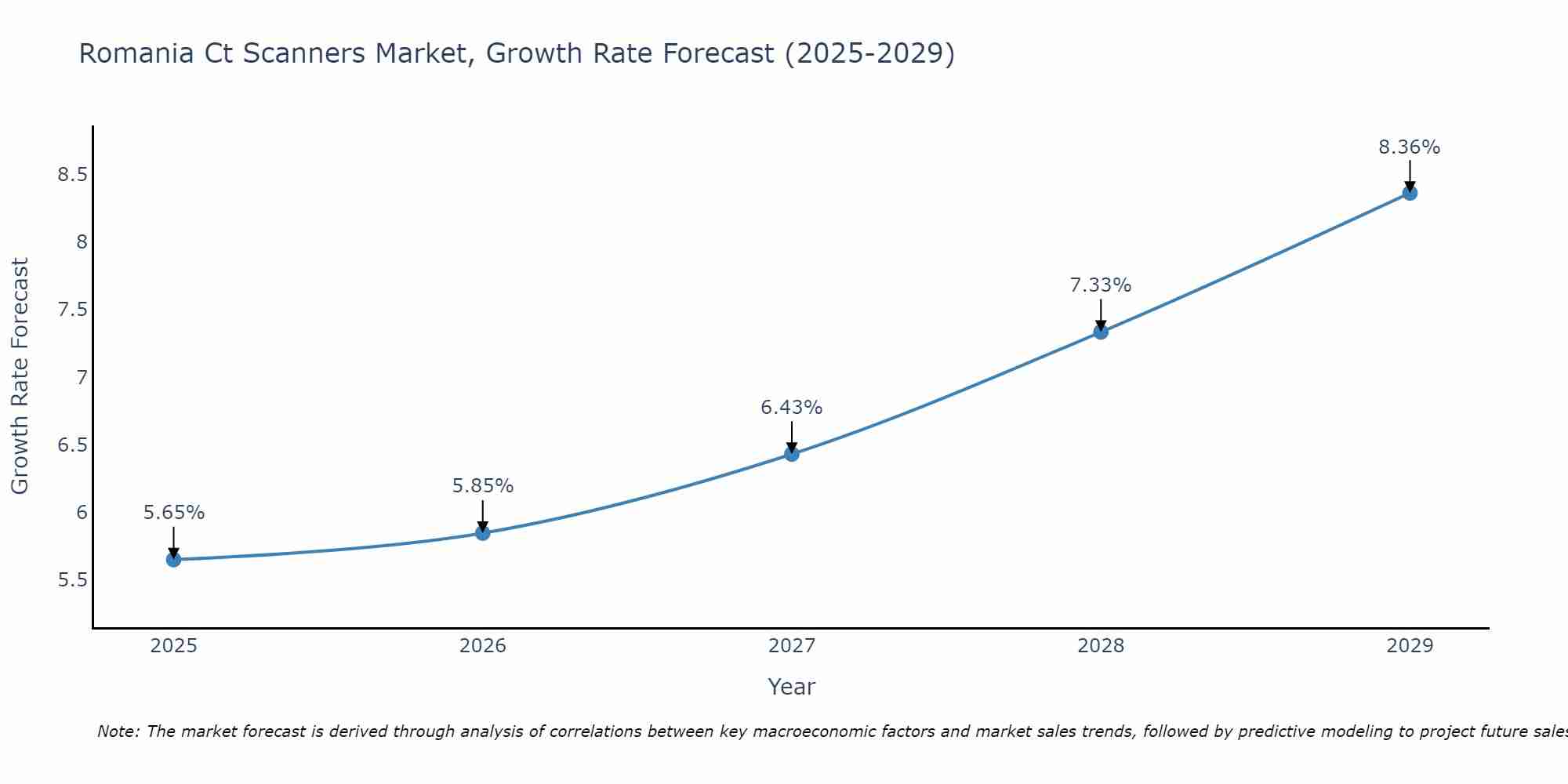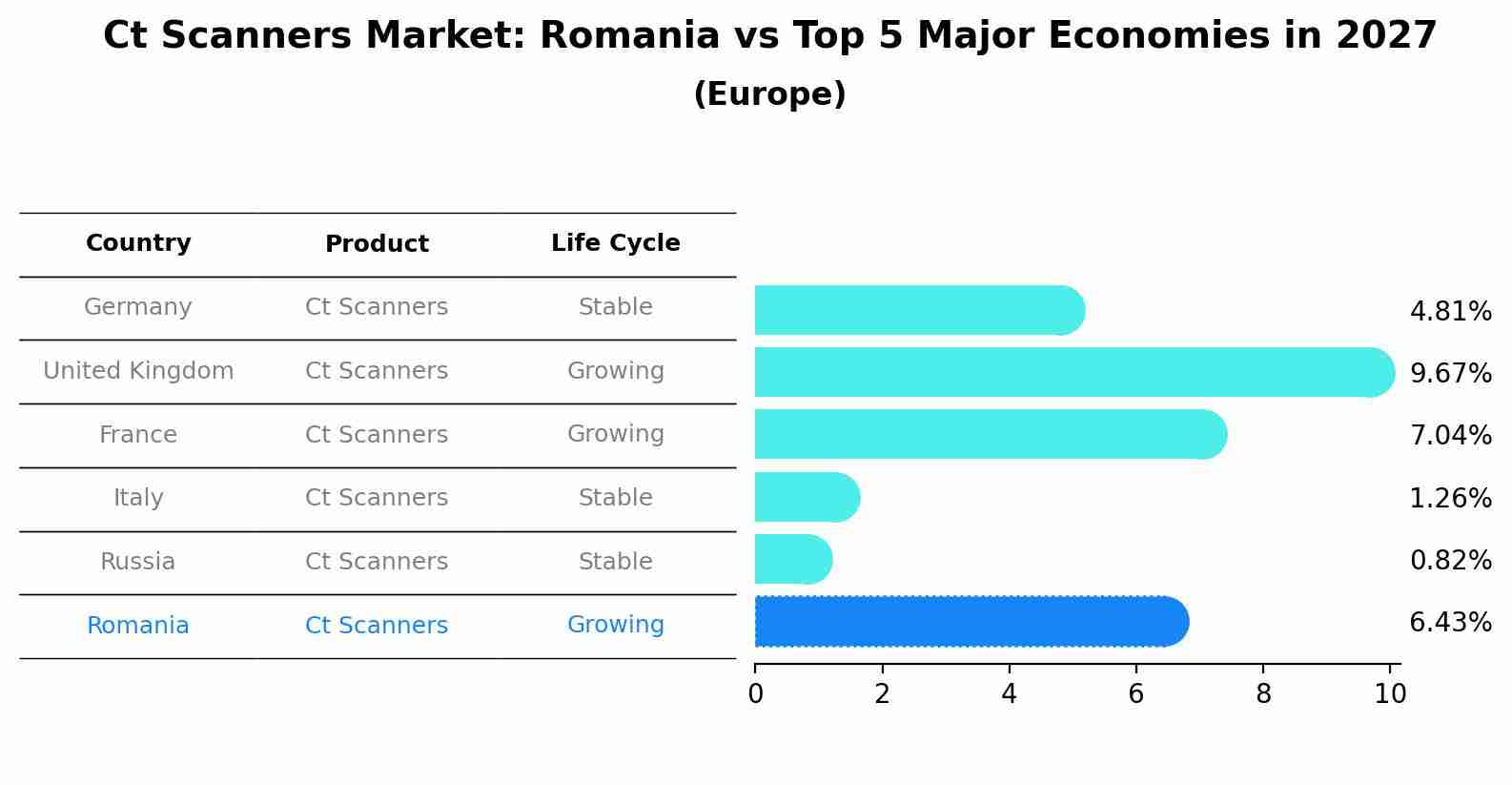Romania Ct Scanners Market (2025-2031) Outlook | Revenue, Share, Companies, Forecast, Trends, Industry, Analysis, Size, Growth & Value
| Product Code: ETC362778 | Publication Date: Aug 2022 | Updated Date: Aug 2025 | Product Type: Market Research Report | |
| Publisher: 6Wresearch | Author: Dhaval Chaurasia | No. of Pages: 75 | No. of Figures: 35 | No. of Tables: 20 |
Romania Ct Scanners Market Size Growth Rate
The Romania Ct Scanners Market is likely to experience consistent growth rate gains over the period 2025 to 2029. Commencing at 5.65% in 2025, growth builds up to 8.36% by 2029.

Ct Scanners Market: Romania vs Top 5 Major Economies in 2027 (Europe)
The Ct Scanners market in Romania is projected to grow at a growing growth rate of 6.43% by 2027, within the Europe region led by Germany, along with other countries like United Kingdom, France, Italy and Russia, collectively shaping a dynamic and evolving market environment driven by innovation and increasing adoption of emerging technologies.

Romania Ct Scanners Market Synopsis
The Romania CT scanners market is experiencing steady growth driven by increasing demand for advanced medical imaging technologies in the healthcare sector. Factors such as rising prevalence of chronic diseases, technological advancements in CT scanners, and government initiatives to improve healthcare infrastructure are contributing to the market expansion. Private investments in healthcare facilities and growing awareness about early disease detection are further boosting market growth. Key players in the Romania CT scanners market are focusing on innovations such as portable and handheld CT scanners to cater to the evolving needs of healthcare providers. With a growing emphasis on early diagnosis and personalized treatment, the CT scanners market in Romania is poised for continued growth in the coming years.
Romania Ct Scanners Market Trends
The current trends in the Romania CT Scanners Market include a growing demand for advanced imaging technologies such as multi-slice CT scanners for more accurate and faster diagnostic capabilities. There is also a shift towards portable and compact CT scanners to improve accessibility in smaller healthcare facilities and for point-of-care applications. Additionally, there is an increasing focus on AI-powered image reconstruction and analysis software to enhance diagnostic accuracy and efficiency. The market is witnessing a rise in partnerships and collaborations between medical device manufacturers and healthcare providers to introduce innovative CT scanner solutions tailored to the specific needs of the Romanian healthcare system. Overall, the Romania CT Scanners Market is experiencing a trend towards technological advancements, increased accessibility, and strategic collaborations to meet the evolving demands of healthcare professionals and patients.
Romania Ct Scanners Market Challenges
In the Romania CT scanners market, one of the key challenges faced is the limited healthcare budget and investment in advanced medical equipment. This can lead to a slower adoption rate of newer and more expensive CT scanner technologies, impacting the overall market growth. Additionally, the presence of a limited number of healthcare facilities with advanced imaging capabilities in certain regions of Romania can hinder the widespread accessibility of CT scanners for patients. Furthermore, regulatory hurdles and compliance requirements in terms of equipment standards and quality assurance also pose challenges for CT scanner manufacturers and healthcare providers in the market. Overcoming these challenges will require strategic pricing strategies, increased public and private investments in healthcare infrastructure, and regulatory reforms to promote the adoption of advanced CT scanner technologies in Romania.
Romania Ct Scanners Market Investment Opportunities
The Romania CT scanners market presents various investment opportunities due to the increasing demand for advanced medical imaging technologies in the country`s healthcare sector. With rising healthcare expenditure and a growing focus on improving diagnostic capabilities, there is a significant market potential for CT scanners in Romania. Investors can explore opportunities in supplying high-quality CT scanners to hospitals, diagnostic imaging centers, and other healthcare facilities. Additionally, there is a growing trend towards the adoption of innovative features such as AI integration and mobile CT scanners, which could offer further avenues for investment and differentiation in the market. Collaborating with local healthcare providers, offering training and maintenance services, or leveraging government initiatives to upgrade medical equipment can also be strategic investment options in the Romania CT scanners market.
Jordan Agar Market Government Policies
The Romanian government has implemented various policies related to the Ct scanners market to ensure quality healthcare services. These policies include regulations on the procurement and maintenance of Ct scanners to guarantee patient safety and accuracy in diagnostics. The government also offers financial incentives and subsidies to healthcare facilities investing in Ct scanner technology to improve accessibility and affordability of these services for the general population. Additionally, there are guidelines in place for the training and certification of healthcare professionals operating Ct scanners to uphold standards of care and proficiency. Overall, the government`s policies aim to promote the growth and advancement of the Ct scanners market in Romania while prioritizing patient welfare and healthcare quality.
Romania Ct Scanners Market Future Outlook
The Romania CT scanners market is expected to witness steady growth in the coming years due to factors such as increasing prevalence of chronic diseases, rising healthcare expenditure, and technological advancements in imaging technology. The market is likely to be driven by the growing demand for advanced diagnostic tools for early disease detection and better treatment outcomes. Additionally, the government`s initiatives to improve healthcare infrastructure and increase access to healthcare services are expected to further fuel the market growth. With a focus on enhancing patient care and improving diagnostic accuracy, the Romania CT scanners market is poised for expansion, offering opportunities for market players to introduce innovative products and expand their presence in the region.
Key Highlights of the Report:
- Romania Ct Scanners Market Outlook
- Market Size of Romania Ct Scanners Market, 2024
- Forecast of Romania Ct Scanners Market, 2031
- Historical Data and Forecast of Romania Ct Scanners Revenues & Volume for the Period 2021 - 2031
- Romania Ct Scanners Market Trend Evolution
- Romania Ct Scanners Market Drivers and Challenges
- Romania Ct Scanners Price Trends
- Romania Ct Scanners Porter's Five Forces
- Romania Ct Scanners Industry Life Cycle
- Historical Data and Forecast of Romania Ct Scanners Market Revenues & Volume By Type for the Period 2021 - 2031
- Historical Data and Forecast of Romania Ct Scanners Market Revenues & Volume By Stationary CT scanners for the Period 2021 - 2031
- Historical Data and Forecast of Romania Ct Scanners Market Revenues & Volume By Portable CT scanners for the Period 2021 - 2031
- Historical Data and Forecast of Romania Ct Scanners Market Revenues & Volume By Device Architecture for the Period 2021 - 2031
- Historical Data and Forecast of Romania Ct Scanners Market Revenues & Volume By C-arm CT Scanners for the Period 2021 - 2031
- Historical Data and Forecast of Romania Ct Scanners Market Revenues & Volume By O-arm CT Scanners for the Period 2021 - 2031
- Historical Data and Forecast of Romania Ct Scanners Market Revenues & Volume By Technology for the Period 2021 - 2031
- Historical Data and Forecast of Romania Ct Scanners Market Revenues & Volume By High-slice CT for the Period 2021 - 2031
- Historical Data and Forecast of Romania Ct Scanners Market Revenues & Volume By Mid-slice CT for the Period 2021 - 2031
- Historical Data and Forecast of Romania Ct Scanners Market Revenues & Volume By Low-slice CT for the Period 2021 - 2031
- Historical Data and Forecast of Romania Ct Scanners Market Revenues & Volume By Cone-beam CT for the Period 2021 - 2031
- Historical Data and Forecast of Romania Ct Scanners Market Revenues & Volume By Application for the Period 2021 - 2031
- Historical Data and Forecast of Romania Ct Scanners Market Revenues & Volume By Human Application for the Period 2021 - 2031
- Historical Data and Forecast of Romania Ct Scanners Market Revenues & Volume By Diagnostic Applications for the Period 2021 - 2031
- Historical Data and Forecast of Romania Ct Scanners Market Revenues & Volume By Cardiology Applications for the Period 2021 - 2031
- Historical Data and Forecast of Romania Ct Scanners Market Revenues & Volume By Oncology Applications for the Period 2021 - 2031
- Historical Data and Forecast of Romania Ct Scanners Market Revenues & Volume By Neurology Applications for the Period 2021 - 2031
- Historical Data and Forecast of Romania Ct Scanners Market Revenues & Volume By Intraoperative Applications for the Period 2021 - 2031
- Historical Data and Forecast of Romania Ct Scanners Market Revenues & Volume By Veterinary Application for the Period 2021 - 2031
- Historical Data and Forecast of Romania Ct Scanners Market Revenues & Volume By Research Application for the Period 2021 - 2031
- Romania Ct Scanners Import Export Trade Statistics
- Market Opportunity Assessment By Type
- Market Opportunity Assessment By Device Architecture
- Market Opportunity Assessment By Technology
- Market Opportunity Assessment By Application
- Romania Ct Scanners Top Companies Market Share
- Romania Ct Scanners Competitive Benchmarking By Technical and Operational Parameters
- Romania Ct Scanners Company Profiles
- Romania Ct Scanners Key Strategic Recommendations
Frequently Asked Questions About the Market Study (FAQs):
- Single User License$ 1,995
- Department License$ 2,400
- Site License$ 3,120
- Global License$ 3,795
Search
Thought Leadership and Analyst Meet
Our Clients
Related Reports
- Canada Oil and Gas Market (2026-2032) | Share, Segmentation, Value, Industry, Trends, Forecast, Analysis, Size & Revenue, Growth, Competitive Landscape, Outlook, Companies
- Germany Breakfast Food Market (2026-2032) | Industry, Share, Growth, Size, Companies, Value, Analysis, Revenue, Trends, Forecast & Outlook
- Australia Briquette Market (2025-2031) | Growth, Size, Revenue, Forecast, Analysis, Trends, Value, Share, Industry & Companies
- Vietnam System Integrator Market (2025-2031) | Size, Companies, Analysis, Industry, Value, Forecast, Growth, Trends, Revenue & Share
- ASEAN and Thailand Brain Health Supplements Market (2025-2031) | Strategy, Consumer Insights, Analysis, Investment Trends, Opportunities, Growth, Size, Share, Industry, Revenue, Segments, Value, Segmentation, Supply, Forecast, Restraints, Outlook, Competition, Drivers, Trends, Demand, Pricing Analysis, Competitive, Strategic Insights, Companies, Challenges
- ASEAN Bearings Market (2025-2031) | Strategy, Consumer Insights, Analysis, Investment Trends, Opportunities, Growth, Size, Share, Industry, Revenue, Segments, Value, Segmentation, Supply, Forecast, Restraints, Outlook, Competition, Drivers, Trends, Demand, Pricing Analysis, Competitive, Strategic Insights, Companies, Challenges
- Europe Flooring Market (2025-2031) | Outlook, Share, Industry, Trends, Forecast, Companies, Revenue, Size, Analysis, Growth & Value
- Saudi Arabia Manlift Market (2025-2031) | Outlook, Size, Growth, Trends, Companies, Industry, Revenue, Value, Share, Forecast & Analysis
- Uganda Excavator, Crane, and Wheel Loaders Market (2025-2031) | Strategy, Consumer Insights, Analysis, Investment Trends, Opportunities, Growth, Size, Share, Industry, Revenue, Segments, Value, Segmentation, Supply, Forecast, Restraints, Outlook, Competition, Drivers, Trends, Demand, Pricing Analysis, Competitive, Strategic Insights, Companies, Challenges
- Rwanda Excavator, Crane, and Wheel Loaders Market (2025-2031) | Strategy, Consumer Insights, Analysis, Investment Trends, Opportunities, Growth, Size, Share, Industry, Revenue, Segments, Value, Segmentation, Supply, Forecast, Restraints, Outlook, Competition, Drivers, Trends, Demand, Pricing Analysis, Competitive, Strategic Insights, Companies, Challenges
Industry Events and Analyst Meet
Whitepaper
- Middle East & Africa Commercial Security Market Click here to view more.
- Middle East & Africa Fire Safety Systems & Equipment Market Click here to view more.
- GCC Drone Market Click here to view more.
- Middle East Lighting Fixture Market Click here to view more.
- GCC Physical & Perimeter Security Market Click here to view more.
6WResearch In News
- Doha a strategic location for EV manufacturing hub: IPA Qatar
- Demand for luxury TVs surging in the GCC, says Samsung
- Empowering Growth: The Thriving Journey of Bangladesh’s Cable Industry
- Demand for luxury TVs surging in the GCC, says Samsung
- Video call with a traditional healer? Once unthinkable, it’s now common in South Africa
- Intelligent Buildings To Smooth GCC’s Path To Net Zero


















